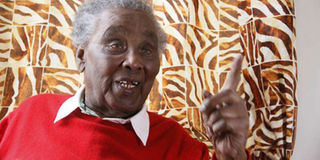Ntimama's successor will have to first be a unifier

Former Cabinet Minister William ole Ntimama at his home in Nairobi on July 28, 2016. PHOTO | MARTIN MUKANGU | NATION MEDIA GROUP
What you need to know:
- In a dramatically changing world, it is likely that new generation of Maasai leaders would need to be in tune with their own times and echo society’s changing priorities.
In any case, demographics of new voters across Maasailand have changed.
Voters are increasingly younger, hungry for education and job opportunities, tech-savvy and city-bound, with decreasing affinity for a land-based livelihood.
In many ways, the death of William ole Ntimama marks the end of an era in pan-Maasai leadership. It is, therefore, legitimate to pose the question: Who is the most likely heir to the Ntimama “throne”?
This can only be answered within a socio-historical context. For those who know the history and social structure of the Maasai people, Ntimama’s achievement was unprecedented.
Never before has there been a leader who received universal acknowledgement, acceptance and recognition across all the Maa speaking sub-groups and age sets. Indeed, the Maasai traditional political system never had room for a sovereign leader, a single ruler or guide to the entire Maasai.
The deadly civil wars of the 19th century into the early 20th century, which totally decimated six Maasai sub-groups and nearly wiped out the Laikipia Maasai, were a testimony to sub-group and clan rivalry for wealth and supremacy. Even in post-independence Kenya, Maasai politics had been so divided – until Ntimama came along. And he did this not by anointment or coronation. He earned his moral and political accolades over time and not without tribulation.
To start with, Ntimama astutely selected as his political themes and causes issues that resonated with the Maasai grassroots of his time, which were universal across parliamentary constituencies, clans and even national boundaries. Land rights and territorial integrity of Maasailand, historical injustice and cultural identity were at the core of his politics. The consistency and courage with which he articulated the Maasai’s position catapulted him to the pedestal.
‘GENERAL ASSEMBLY’
Further, Ntimama turned the Suswa Ground into the Maasai’s “general assembly” where the Maasai came to own the agenda of the day and to give their leaders the mandate to take certain positions. If you consider that Suswa was previously where an attack on the Laikipia was plotted, Ntimama had succeeded in turning the place into an arena not for dividing but for uniting.
Geographically, the Maa speaking world covers the El Molo and Rendille of Marsabit, the Samburu of Samburu County, Ilaikipiak of Laikipia County, Ilchamus of Baringo, the counties of Narok and Kajiado and vast swathes of Northern Tanzania. But Narok is the hotbed of Maasai political contestation and, therefore, the place to watch in the Ntimama succession. If Edward Lowassa had succeeded to become President of Tanzania, the Maa supreme leadership would have been his for the taking as, indeed, would have been the case had the late Edward Sokoine before him lived to succeed Mwalimu Julius Nyerere in the earlier years before Ntimama stormed the political scene. After all, before Suswa rose to prominence as the sacred venue for Maasai declarations, Monduli in Tanzania had previously been the cultural Mecca of the Maasai.
SUPREMACY WAR
When both John Keen and Stanley Shapashina Oloitiptip lost the supremacy war to Justus Kandet ole Tipis, the political centre of gravity shifted to Narok. Former Vice-President George Saitoti could have returned it to Kajiado but his legitimacy was undermined by his ethnic ambiguity and inability to speak the Maa language. Ideally Interior Cabinet Secretary Joseph Nkaissery was also most favoured to return the baton to Kajiado. However, being an appointed bureaucrat and not an elected representative free to speak his mind has limited his possibilities, Moreover, the arrest of elected leaders in Narok last year following demonstrations against the county government while Nkaissery served as the security chief, seems to have rubbed the grassroots the wrong way and portrayed him as more likely to stand with the state at certain crunch times rather than with the Maasai .
Whoever will eventually succeed in filling the space left open by Ntimama will have to first be a unifier. Like Ntimama, he (or she) would have to focus on the issues that cut across the entire Maasai people and downplay the divisive ones.
In a dramatically changing world, whereas land will perhaps remain an issue, it is likely that the new generation of Maasai leaders would need to be in tune with their own times and echo the society’s changing priorities.
In any case, the demographics of the new voters across Maasailand have changed too. Voters are increasingly younger, hungry for education and job opportunities, tech-savvy and city-bound, with decreasing affinity for a land-based livelihood.
Sironka ole Masharen is the author of ‘The Maasai Pioneers’.




